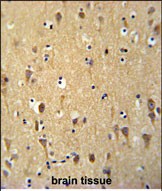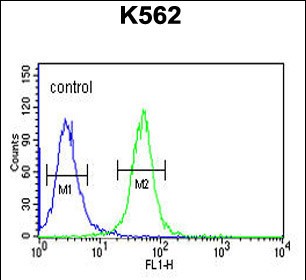WDR73 Antibody (N-term)
Affinity Purified Rabbit Polyclonal Antibody (Pab)
- SPECIFICATION
- CITATIONS
- PROTOCOLS
- BACKGROUND

Application
| FC, IHC-P, WB, E |
|---|---|
| Primary Accession | Q6P4I2 |
| Reactivity | Human |
| Host | Rabbit |
| Clonality | Polyclonal |
| Isotype | Rabbit IgG |
| Calculated MW | 41685 Da |
| Antigen Region | 44-73 aa |
| Gene ID | 84942 |
|---|---|
| Other Names | WD repeat-containing protein 73, WDR73 |
| Target/Specificity | This WDR73 antibody is generated from rabbits immunized with a KLH conjugated synthetic peptide between 44-73 amino acids from the N-terminal region of human WDR73. |
| Dilution | FC~~1:10~50 IHC-P~~1:50~100 WB~~1:1000 E~~Use at an assay dependent concentration. |
| Format | Purified polyclonal antibody supplied in PBS with 0.09% (W/V) sodium azide. This antibody is purified through a protein A column, followed by peptide affinity purification. |
| Storage | Maintain refrigerated at 2-8°C for up to 2 weeks. For long term storage store at -20°C in small aliquots to prevent freeze-thaw cycles. |
| Precautions | WDR73 Antibody (N-term) is for research use only and not for use in diagnostic or therapeutic procedures. |
| Name | WDR73 {ECO:0000303|PubMed:25466283, ECO:0000312|HGNC:HGNC:25928} |
|---|---|
| Function | Component of a multiprotein complex required for the assembly of the RNA endonuclease module of the integrator complex (PubMed:39032489). Associates with INTS9 and INTS11 in the cytoplasm, stabilizing the INTS9-INTS11 heterodimer and blocking the active site of INTS11 (PubMed:39032489). BRAT1 then joins the complex and plugs the active site of INTS11, leading to WDR73 release and nuclear import of INTS9 and INTS11 (PubMed:39032489). |
| Cellular Location | Cytoplasm. Cytoplasm, cytoskeleton, spindle. Cytoplasm, cytoskeleton, spindle pole. Cleavage furrow. Note=During interphase, located in the cytoplasm (PubMed:25466283). During mitosis, accumulates at the spindle poles and microtubule asters and later in the cleavage furrow (PubMed:25466283). |
| Tissue Location | Expressed in kidney and brain. In the kidney, expressed in glomeruli, most probably in podocytes, and in tubules (at protein level). In the brain, expressed in the cerebellum, with high levels in Purkinje cells and their projecting axons, in the deep cerebellar nuclei and in pyramidal neurons of the cerebral cortex (at protein level). In the white matter, mainly present in astrocytes, but not in oligodendrocytes (at protein level). Also highly expressed in endothelial cells of cerebral capillaries (at protein level) |

Thousands of laboratories across the world have published research that depended on the performance of antibodies from Abcepta to advance their research. Check out links to articles that cite our products in major peer-reviewed journals, organized by research category.
info@abcepta.com, and receive a free "I Love Antibodies" mug.
Provided below are standard protocols that you may find useful for product applications.
References
Suzuki, Y., et al. Gene 200 (1-2), 149-156 (1997)
If you have used an Abcepta product and would like to share how it has performed, please click on the "Submit Review" button and provide the requested information. Our staff will examine and post your review and contact you if needed.
If you have any additional inquiries please email technical services at tech@abcepta.com.













 Foundational characteristics of cancer include proliferation, angiogenesis, migration, evasion of apoptosis, and cellular immortality. Find key markers for these cellular processes and antibodies to detect them.
Foundational characteristics of cancer include proliferation, angiogenesis, migration, evasion of apoptosis, and cellular immortality. Find key markers for these cellular processes and antibodies to detect them. The SUMOplot™ Analysis Program predicts and scores sumoylation sites in your protein. SUMOylation is a post-translational modification involved in various cellular processes, such as nuclear-cytosolic transport, transcriptional regulation, apoptosis, protein stability, response to stress, and progression through the cell cycle.
The SUMOplot™ Analysis Program predicts and scores sumoylation sites in your protein. SUMOylation is a post-translational modification involved in various cellular processes, such as nuclear-cytosolic transport, transcriptional regulation, apoptosis, protein stability, response to stress, and progression through the cell cycle. The Autophagy Receptor Motif Plotter predicts and scores autophagy receptor binding sites in your protein. Identifying proteins connected to this pathway is critical to understanding the role of autophagy in physiological as well as pathological processes such as development, differentiation, neurodegenerative diseases, stress, infection, and cancer.
The Autophagy Receptor Motif Plotter predicts and scores autophagy receptor binding sites in your protein. Identifying proteins connected to this pathway is critical to understanding the role of autophagy in physiological as well as pathological processes such as development, differentiation, neurodegenerative diseases, stress, infection, and cancer.




